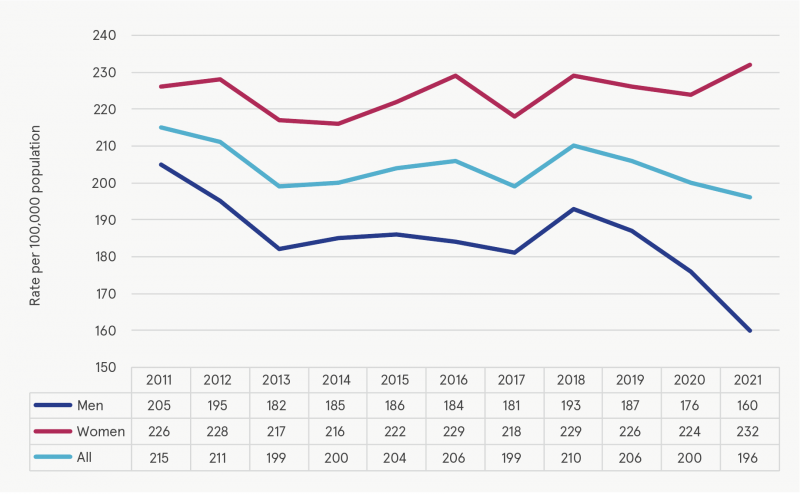Millar, Seán  ORCID: https://orcid.org/0000-0003-4453-8446
(2024)
National Self-Harm Registry Ireland annual report, 2021.
Drugnet Ireland,
Issue 88, Summer 2024,
pp. 23-25.
ORCID: https://orcid.org/0000-0003-4453-8446
(2024)
National Self-Harm Registry Ireland annual report, 2021.
Drugnet Ireland,
Issue 88, Summer 2024,
pp. 23-25.
| Preview | Title | Contact |
|---|---|---|
|
PDF (Drugnet Ireland 88)
1MB |
The 2021 annual report from National Self-Harm Registry Ireland was published in February 2024.1 The report contains information relating to every recorded presentation of deliberate self-harm to acute hospital emergency departments in Ireland in 2021 and complete national coverage of cases treated. All individuals who were alive on admission to hospital following deliberate self-harm were included, along with the methods of deliberate self-harm that were used. Accidental overdoses of medication, street drugs, or alcohol were not included.
Rates of self-harm
In 2021, National Self-Harm Registry Ireland recorded 11,415 presentations to hospitals as a result of self-harm, involving 8,595 individuals. Adjusting for the absence of data from two hospitals, it was estimated that there was a total of 12,661 self-harm presentations made by 9,533 individuals in 2021. Taking the population into account, the age-standardised rate of individuals presenting to hospital in the Republic of Ireland following self-harm was 196 per 100,000 population (see Figure 1). This was a decrease of 2% compared with the rate recorded in 2020 (200 per 100,000) and 12% lower than the peak rate recorded by the registry in 2010 (223 per 100,000).
In 2021, the national male rate of self-harm was 160 per 100,000 population, 9% lower than in 2020, and the lowest ever-recorded by the registry. The female rate was 232 per 100,000 population, which was 4% higher than in 2020. With regard to age, the peak rate for men was in the 20—24-age group, at 387 per 100,000 population. As seen in previous years, the peak rate for women was among 15—19-year-olds, at 888 per 100,000 population.
Self-harm and drug and alcohol use
Intentional drug overdose (IDO) was the most common form of deliberate self-harm reported in 2021, occurring in 6,956 (60.9%) of episodes. As observed in 2020, overdose rates were higher among women (65.1%) than among men (54.9%). Minor tranquillisers and major tranquillisers were involved in 28% and 10% of drug overdose acts, respectively. In total, 35% of male and 50% of female overdose cases involved analgesic drugs, most commonly paracetamol, which was involved in 33% of all drug overdose acts. In 67% of cases, the total number of tablets taken was known, with an average of 27 tablets taken in episodes of self-harm that involved a drug overdose.
Although the proportion of self-harm presentations to hospital involving IDO in 2021 was similar to that recorded in 2020, there was a reduction in self-harm presentations involving street/illegal drugs in 2021, specifically for men. While the female rate remains similar to that reported in 2020, the male rate was reduced by almost one-third. Between 2007 and 2021, the rate per 100,000 of IDO involving illegal drugs increased by 31% for men, while the female rate has almost doubled.
Cocaine and cannabis were the most common street drugs recorded by the registry in 2021, present in 7% and 3% of overdose acts, respectively. Cocaine was more common among men than women and was involved in 20% of overdose acts by 25—34-year-olds. Cannabis was most common among men aged 15—24 years and was present in 7% of overdose acts. Alcohol was involved in 30% of presentations. It was more likely to be involved in male compared with female presentations (36% vs 26% respectively).

Source: National Suicide Research Foundation (2024)1
‘All’ in the legend refers to the rate for both men and women per 100,000 population.
Figure 1: Person-based rate of deliberate self-harm from 2011 to 2021, by sex
Recommendations
The authors noted that over the past 20 years, the highest rates of self-harm have consistently been observed among young people, underlining the need for upstream and preventative interventions such as school-based universal mental health programmes that have been found to be effective in preventing suicide attempts in young adolescents.
1 Joyce M, Chakraborty S, Hursztyn P, et al. (2024) National Self-Harm Registry Ireland annual report 2021. Cork: National Suicide Research Foundation. Available from: https://www.drugsandalcohol.ie/40475/
Repository Staff Only: item control page